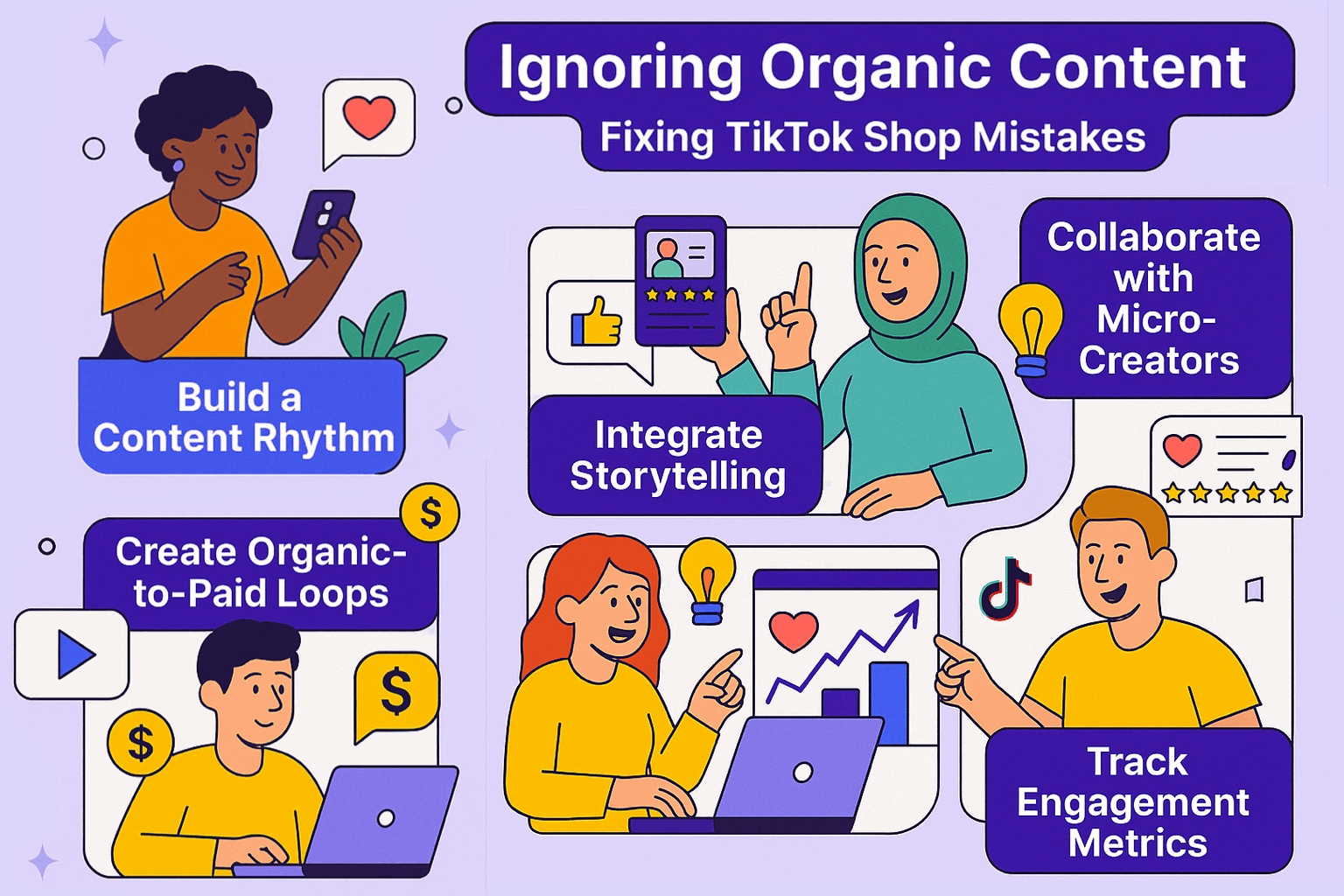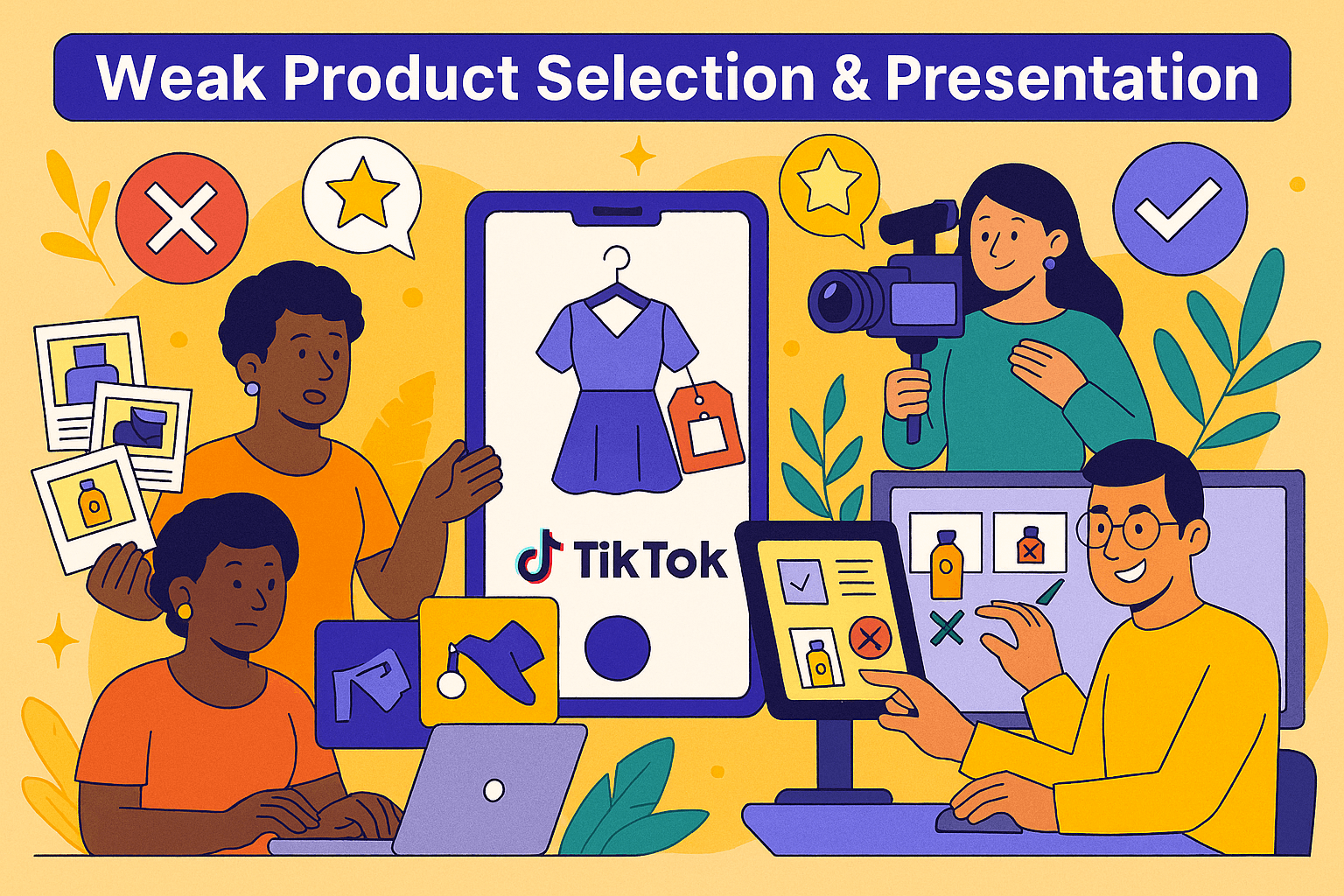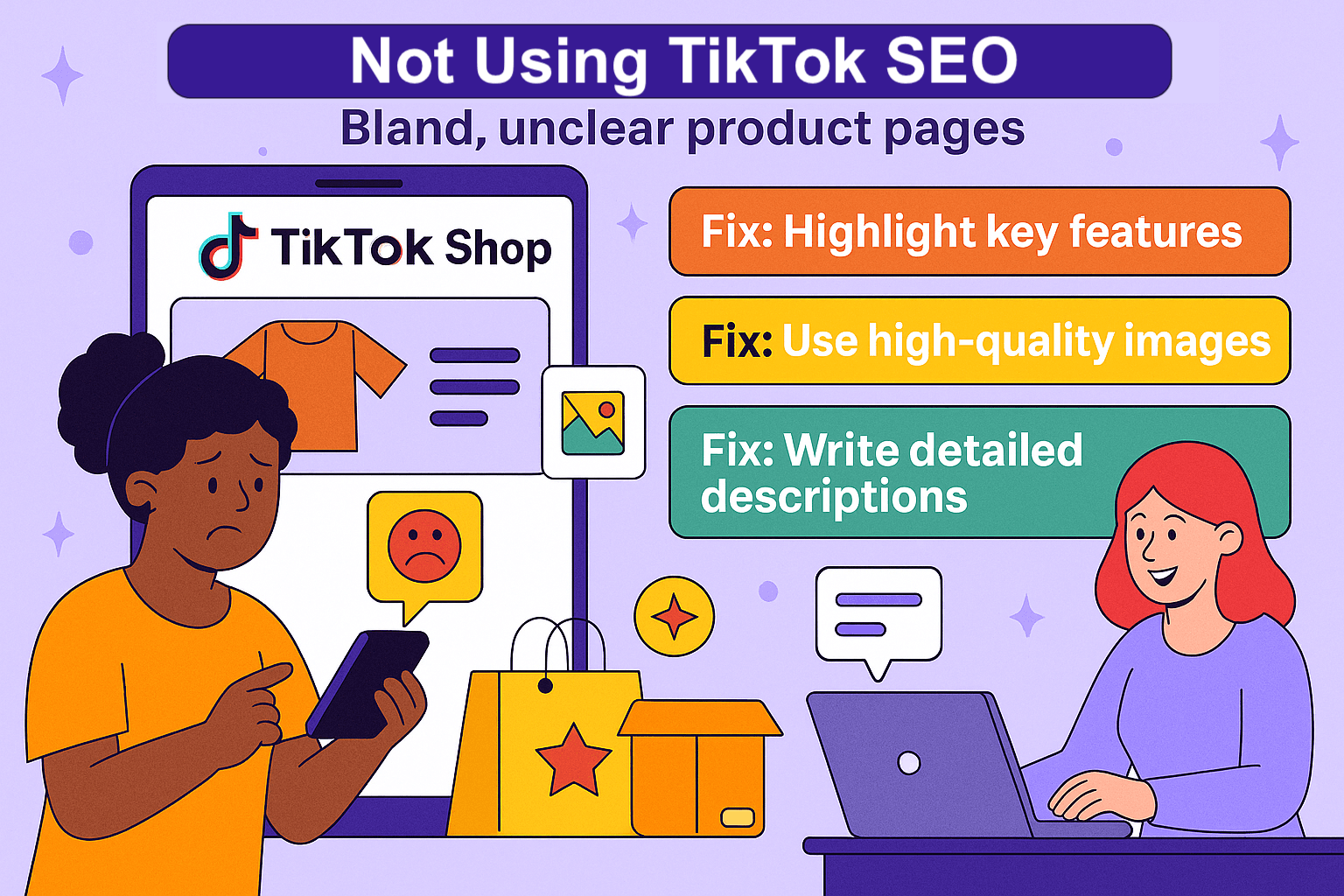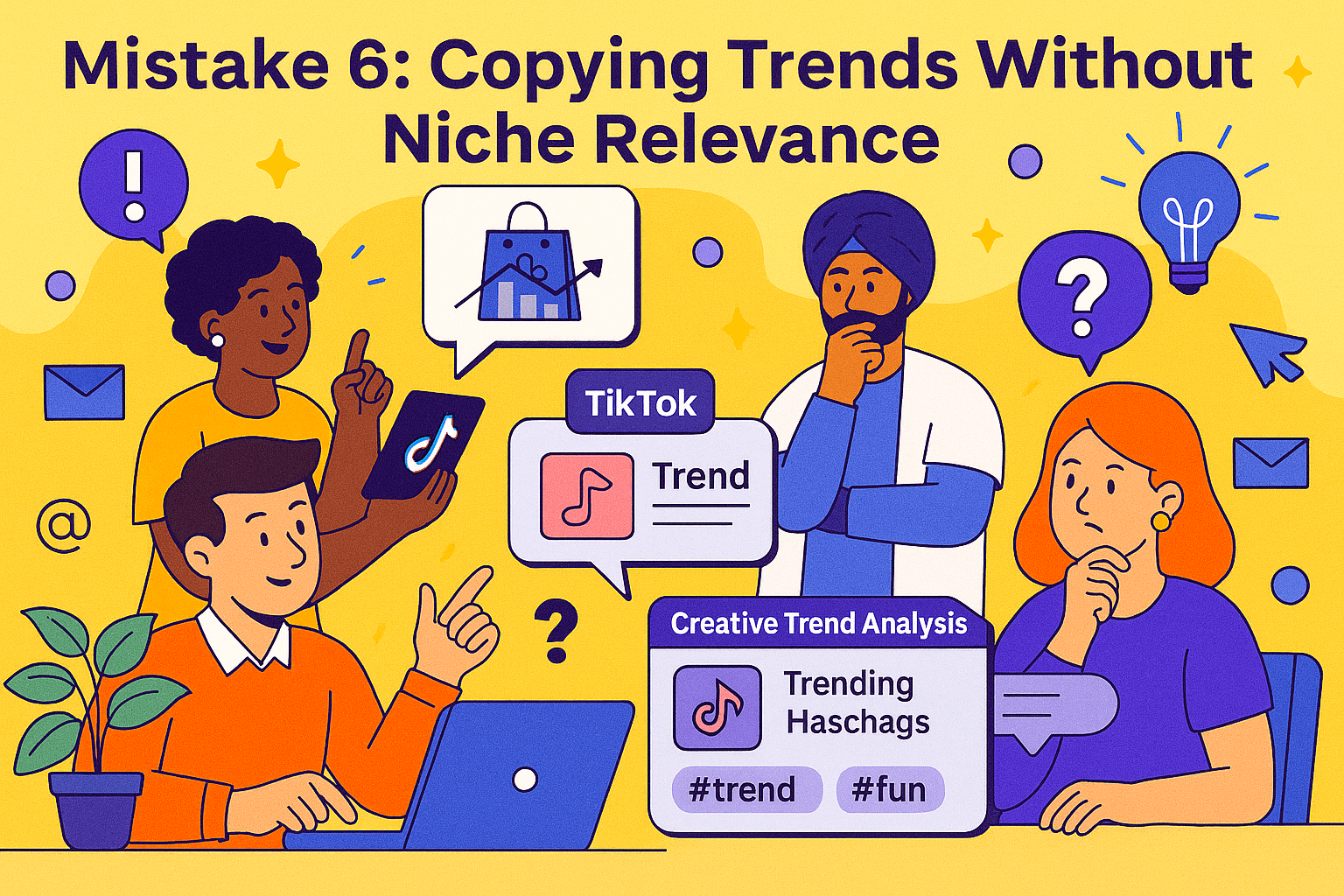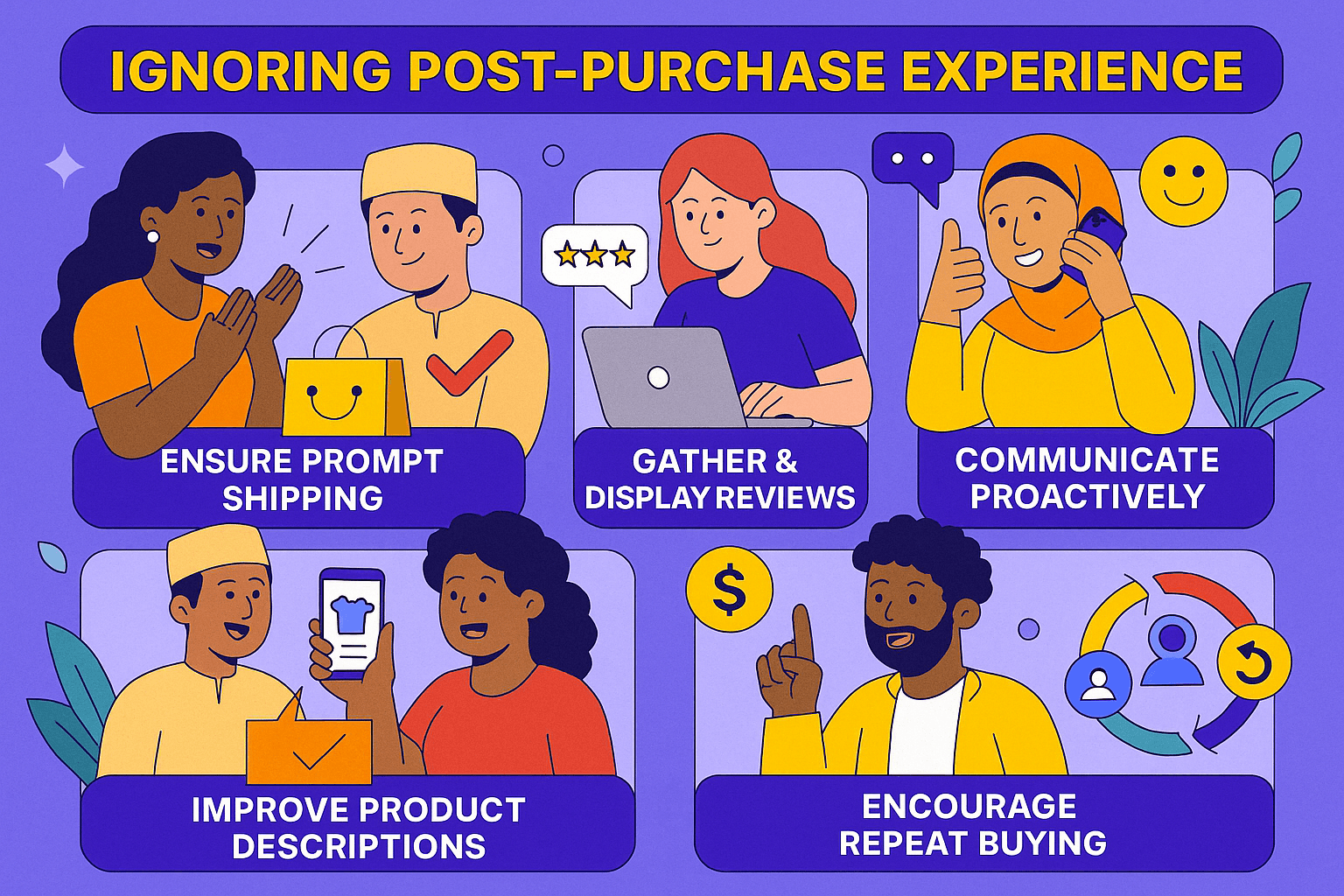Mistake 1
Ignoring Organic Content
(Why Relying Only on Ads Kills Sales)
One of the most damaging TikTok Shop mistakes in 2025 is treating the platform purely as a paid advertising channel. Many sellers assume that running in-feed or Spark Ads alone will guarantee sales. In reality, TikTok’s algorithm increasingly rewards authenticity, engagement, and consistency. Without organic content feeding that system, ad performance suffers dramatically over time.
In 2024 and 2025, data from multiple agencies and sellers confirmed this trend. Darkroom Agency’s TikTok Shop Playbook reported that brands relying exclusively on paid media saw a 50% higher cost-per-click and 40% lower retention rates compared to those that mixed ads with organic posts. On TikTok Shop Seller forums, sellers shared real examples of ad fatigue appearing within days because their feeds had no fresh, non-promotional content to support ongoing engagement.
Why This Mistake Happens
Most sellers entering TikTok Shop come from platforms like Amazon, Lazada, or Shopify. They are used to transactional environments where ads, keywords, and listings drive the majority of sales. TikTok, however, operates as a discovery-driven ecosystem powered by entertainment and connection. Sellers who fail to understand this difference end up producing static product clips or stock-style videos that the algorithm quickly deprioritizes.
Another common cause is misunderstanding TikTok’s engagement-based ranking. TikTok’s recommendation system evaluates not only video performance but also the overall engagement health of an account. When an account posts infrequently or only promotes, the system categorizes it as “low authenticity,” which limits organic reach and inflates ad costs.
Real Example
A US-based skincare brand documented its results in a 2024 seller group: after pausing organic posts for two weeks and relying entirely on Spark Ads, their campaign CTR fell from 2.8% to 1.3%. When they resumed posting daily “behind-the-scenes” and customer testimonial clips, their ad engagement and live shopping conversions rebounded within days. This shows how TikTok’s algorithm connects ad performance directly with organic trust signals.
How to Fix It
- Build a content rhythm.
Post at least three to five organic videos per week, showcasing different aspects of your brand — packaging, customer reactions, how-to demonstrations, or trending sounds that fit your niche. The goal is not to advertise but to appear active, relatable, and genuine. - Create a loop between organic and paid content.
Test new video ideas organically. Once a post performs well (high watch time, saves, or comments), convert it into a Spark Ad to scale. This “organic-to-paid” bridge reduces ad fatigue and ensures that your money amplifies content TikTok’s algorithm already trusts. - Collaborate with micro-creators.
Partner with smaller influencers (5,000–50,000 followers) who have loyal, niche audiences. Encourage them to create unfiltered UGC videos featuring your product. These clips tend to outperform studio ads and can be boosted later for wider reach. - Integrate storytelling.
Instead of repetitive product demos, share stories — customer journeys, production insights, or even short vlogs from your team. TikTok prioritizes narrative-based content because it sustains audience attention, increasing the likelihood of repeat impressions. - Track engagement metrics.
Monitor average watch duration, shares, and saves — not just likes or views. Consistent engagement on organic content feeds TikTok’s “interest graph,” which directly influences ad visibility and CPC efficiency.
Organic content is the foundation of every successful TikTok Shop strategy. It builds credibility, supports the algorithm’s trust signals, and ensures paid campaigns are amplified rather than wasted. Sellers who skip organic content often see short-term clicks but long-term decline. In 2025, brands that win are those that balance storytelling and sales seamlessly — treating TikTok not as a billboard, but as a relationship platform.
Mistake 2
Weak Product Selection & Presentation
(Destroying Conversions Before You Start)
Many TikTok Shop sellers fail before their first sale — not because of lack of traffic, but because their product selection and presentation don’t match TikTok’s audience behavior. Unlike traditional e-commerce, TikTok’s viral loop depends on emotional resonance and relatability. A product that looks “good on paper” might flop if it doesn’t fit the culture, trends, or storytelling style native to the app.
In 2025, a growing number of failed TikTok shops had high ad impressions but extremely low conversion rates. According to MarketRocket’s 2024 TikTok Retail Report, over 60% of sellers who experienced stagnant growth listed “irrelevant products or poor visuals” as their top mistake. Common examples include trying to sell bulk home appliances, non-visual tools, or unbranded items that lack clear use-case storytelling.
Why This Mistake Happens
Most sellers approach TikTok Shop using a catalogue-first mindset, importing the same products they list on Amazon or Shopee. But TikTok’s culture prioritizes curiosity and identity. Sellers who fail to consider entertainment value or lifestyle fit end up with listings that users scroll past instantly.
Another core issue is presentation inconsistency. Low-quality images, cluttered thumbnails, and non-native video content instantly lower perceived credibility. TikTok’s users expect authenticity — but not amateurism. Sellers using heavily watermarked supplier videos or unedited stock clips lose trust immediately.
Real Example
A UK-based fashion retailer featured in Wired’s 2024 E-commerce Trends Report saw an initial viral burst but rapid drop-off when its clothing catalog included items with mismatched lighting, background colors, and inconsistent models. After standardizing visuals and re-shooting short-form try-on clips in TikTok’s native style, their conversion rate doubled within two weeks. This demonstrates that content coherence directly impacts purchasing intent.
How to Fix It
- Choose products that visually “perform.”
TikTok thrives on motion and emotion. Select items that can be demonstrated through quick transformations, before-and-after reveals, or interactive use. Products like beauty tools, DIY kits, and lifestyle gadgets perform better because they are easy to visualize. - Use TikTok-native visuals.
Record product showcases in vertical video format with natural lighting and real people. Avoid overproduced videos that look like TV commercials. The most effective clips feel spontaneous yet purposeful, mimicking influencer content rather than ads. - Create consistency in product imagery.
Maintain uniform backgrounds, angles, and colors across your listings. A consistent aesthetic signals professionalism and brand identity. Tools like CapCut or TikTok Creative Center templates help achieve this at scale. - Align your products with trending niches.
Track TikTok trends weekly to see which product categories are driving views (e.g., skincare tools, phone accessories, or mini home décor). Position your items within these cultural conversations using relevant hashtags and content hooks. - Validate through micro-tests.
Before uploading a full catalog, post short organic clips showcasing the product in action. Monitor engagement levels and comments. If viewers show curiosity or request links, the product has organic traction worth scaling.
The difference between a shop that converts and one that stalls is rarely the algorithm — it’s alignment. Products must match TikTok’s visual and emotional rhythm. When your product selection resonates with users’ lifestyles and your presentation looks cohesive, TikTok’s algorithm amplifies your content instead of ignoring it. In 2025, sellers who prioritize storytelling-driven product strategy consistently outperform those focused only on inventory volume.
Mistake 3
Not Using TikTok SEO
(The Missed Visibility Engine Behind Every Sale)
One of the most underestimated TikTok Shop mistakes in 2025 is neglecting TikTok SEO. While most sellers focus on ads and viral hooks, few realize that TikTok’s internal search has quietly become a discovery engine rivaling Google for Gen Z and Millennials. TikTok SEO — optimizing your video captions, keywords, and on-screen text — is now one of the strongest drivers of organic product visibility.
TikTok’s algorithm increasingly surfaces videos in its search results when the metadata, captions, and audio align with trending queries. A well-optimized TikTok Shop listing doesn’t just appear on the For You Page; it shows up when users search for “best skincare gadgets,” “TikTok shop mini humidifier,” or “budget beauty finds.” Ignoring this layer of optimization means leaving consistent, high-intent traffic untapped.
Why This Mistake Happens
Many sellers assume that TikTok SEO works like YouTube SEO or Google indexing. In reality, TikTok relies heavily on engagement and keyword density within native formats — including captions, subtitles, and even speech detection from videos. Sellers who skip keyword research or rely on generic hashtags fail to match real user intent.
In 2025, Socialinsider’s TikTok Commerce Study found that 68% of TikTok sellers never use their target keywords in captions or product descriptions. Those that did experienced up to 45% higher visibility within TikTok’s in-app search results. This shift shows how critical contextual keywords are to maintaining visibility amid algorithmic competition.
Real Example
A Thailand-based beauty seller, featured in BigSeller’s 2025 Seller Casebook, struggled with stagnant reach despite daily uploads. After incorporating keyword-optimized captions such as “affordable skincare TikTok Shop routine” and “night serum under $10,” their average view count tripled in less than a month. Their top-performing clip ranked for three search phrases and generated organic conversions without additional ad spend.
How to Fix It
- Identify search-intent keywords. Use TikTok’s search bar autocomplete feature or external tools like Keyword Tool for TikTok to find what users are actively searching. Focus on terms combining your niche + “TikTok Shop,” such as “wireless earbuds TikTok Shop review.”
- Optimize captions and speech. Include your primary keyword naturally in the first sentence of your video caption and speak it on-screen. TikTok’s speech recognition AI indexes verbal keywords — saying them improves discoverability.
- Add descriptive text overlays. Use short, clear on-screen titles with your keywords, such as “Best Budget Kitchen Gadget on TikTok Shop.” Keep text centered and visible for the first three seconds of the video.
- Use strategic hashtags — not generic ones. Combine high-volume tags (#TikTokShopFinds) with niche-specific ones (#SkincareUnder10, #DeskSetupIdeas). Overusing irrelevant hashtags lowers ranking potential.
- Optimize your TikTok Shop product titles. Product listings should match your SEO-friendly video captions. For example, instead of “Mini Humidifier,” use “Portable USB Mini Humidifier – TikTok Shop Trending Gadget 2025.” Consistency between content and listings boosts algorithmic matching.
- Track and adapt weekly. Monitor TikTok search trends and update your video captions accordingly. TikTok’s Discover and Trends tabs change quickly — sellers who adapt their keyword set weekly maintain consistent reach.
TikTok SEO is no longer optional. It’s the backbone of sustained visibility. Sellers who treat TikTok like a search-first platform see ongoing engagement and conversions without relying solely on paid media. The difference between being found and forgotten often comes down to one overlooked keyword in your caption or video script. In 2025, optimizing your content for both algorithm and intent is the smartest move you can make.
Mistake 4
Poor Live Shopping Execution
(Turning the Strongest Feature Into a Weak Link)
TikTok Live Shopping remains one of the most powerful conversion tools on the platform — yet it’s also where most sellers fail. In 2025, TikTok Live streams are responsible for nearly half of all in-app sales, according to TikTok’s 2025 Commerce Insights Report. Despite this, a large number of sellers treat Lives as unplanned, unoptimized broadcasts. Poor preparation, weak product demonstrations, and zero audience interaction cause viewers to drop within seconds, leaving thousands of potential sales untapped.
Recent data from BigSeller’s Live Commerce Benchmark shows that over 70% of new TikTok sellers see fewer than 10 active viewers per live session. The main reason isn’t the algorithm — it’s poor execution. Sellers often go live without scripting, camera setup, or engagement strategy. As a result, viewers lose interest quickly, and the TikTok algorithm stops promoting the stream to more users.
Why This Mistake Happens
Many sellers underestimate the complexity of TikTok Lives. They assume that pressing the “Go Live” button and showcasing products is enough. However, live commerce on TikTok functions like a performance — the algorithm amplifies Lives with engagement spikes, high comment activity, and watch time consistency. If a live session lacks hooks, audience dialogue, and visual energy, it quickly falls below algorithmic thresholds and becomes invisible.
Another frequent issue is poor technical setup. Lives with bad lighting, muffled audio, or laggy streaming signal low professionalism and discourage purchases. Sellers also fail to use TikTok’s built-in features such as pinning products, limited-time offers, or live-exclusive discounts — which are proven to increase conversion rates by up to 35%.
Real Example
In early 2025, a Southeast Asian fashion seller featured in Social Commerce Review saw under 20 concurrent viewers per session. After restructuring their live format into 20-minute themed shows — including product tutorials, audience polls, and countdown offers — their viewer retention increased by 400%. When they began boosting their TikTok Live views during product launches, the algorithm recognized higher engagement and their total reach doubled within two weeks.
How to Fix It
- Plan and script every live session. Create a structured outline that includes an introduction, product sequence, engagement checkpoints, and a closing offer. Treat your Lives like professional events, not casual streams.
- Optimize the technical setup. Use good lighting, a stable tripod, and clear audio. Always test before going live. Add relevant on-screen captions and pin featured products in real-time using TikTok’s Live Shopping tools.
- Boost live visibility strategically. At the start of every live campaign, invest in a small burst of TikTok Live Stream Views to signal the algorithm that your session has active traction. This increases your ranking in TikTok’s “Recommended Lives” section and draws real organic viewers.
- Use time-limited incentives. Offer discounts, free shipping, or gifts for orders placed during the live. This creates urgency and encourages immediate purchases.
- Engage actively with comments. Read viewers’ names, respond to questions, and run polls. TikTok’s system monitors comment frequency as an engagement metric; the more interaction you generate, the longer your live stays discoverable.
- Review performance metrics after each session. Track average watch duration, conversion rate, and number of viewers who clicked pinned products. Use this data to refine your next live structure.
TikTok Live Shopping is not a “bonus feature” — it’s a performance-driven sales engine. Sellers who treat Lives with strategy, structure, and engagement planning often outperform those running traditional ad campaigns. By mastering the rhythm of entertainment and commerce, your Lives can become recurring revenue events instead of one-off experiments.
Mistake 5
Neglecting Analytics
(Flying Blind in a Data-Driven Marketplace)
One of the most costly TikTok Shop mistakes in 2025 is ignoring the analytics dashboard. Sellers who fail to track data are essentially operating in the dark. TikTok’s Commerce Analytics has evolved into a full decision engine—providing conversion rates, click-through data, cart behavior, and even content performance insights. Yet, many sellers only glance at surface-level metrics such as total views or likes, overlooking the signals that truly guide growth and profitability.
According to TikTok’s 2025 Seller Performance Index, more than 55% of underperforming shops either never review analytics or use incomplete data when planning campaigns. This lack of visibility leads to repeated mistakes: wasted ad spend, poor product prioritization, and missed opportunities for cross-selling. In contrast, top sellers who review analytics weekly see 2–3× higher conversion stability over six months.
Why This Mistake Happens
Most small and mid-level sellers treat analytics as a technical burden rather than a growth tool. Many were used to older e-commerce systems where metrics were limited to sales and impressions. On TikTok Shop, however, performance is multi-layered—covering engagement metrics, video retention curves, click-to-cart ratios, and audience demographics. When these insights go unused, sellers cannot identify which products attract attention versus which ones actually convert.
Another cause is a lack of measurement discipline. Sellers often chase trends reactively without testing or comparing outcomes. Without consistent benchmarks, it becomes impossible to understand whether a campaign’s success comes from a strong hook, timing, or the algorithm’s boost cycle.
Real Example
A UK-based electronics seller reported in MarketRocket’s 2025 Data-Driven Commerce Report that after tracking “Add-to-Cart Rate” and “Completion Rate per Video,” they discovered that 70% of their watch-time came from one creator collaboration series. Redirecting ad spend to similar content increased total sales by 48% in a month. The lesson: analytics reveal leverage points invisible to intuition.
How to Fix It
- Audit your analytics dashboard weekly.
Review metrics such as product click-through rate (CTR), add-to-cart rate, checkout completion rate, and average watch time. Use these KPIs to decide which content formats or products deserve scaling. - Identify content-to-conversion links.
Track which videos directly lead to product clicks. TikTok’s “Shop Video Attribution” helps trace how viewers move from content to purchase. Prioritize video styles that generate measurable buying behavior. - Compare paid vs. organic performance.
Evaluate ROAS, CPC, and engagement rate separately for ad campaigns and organic videos. This comparison exposes the true ROI of your paid strategy and prevents over-spending on ineffective promotions. - Set benchmarks and A/B test regularly.
Define what success means—target CTR, retention rate, or order volume. Test different video openings, hooks, or price displays. Use A/B results to refine creative direction scientifically instead of guessing. - Use data to forecast inventory.
Combine analytics insights with product sales velocity to anticipate restocks or seasonal spikes. Data-driven inventory planning reduces delays and improves TikTok’s seller performance score.
Ignoring analytics is not a time-saving choice; it’s a profit-losing one. TikTok’s commerce system favors sellers who respond to data quickly. In 2025, analytics is no longer just a backend feature—it’s your competitive edge. The sellers who monitor, interpret, and act on their data consistently outperform those relying on instinct or luck.
Mistake 6
Copying Trends Without Niche Relevance
(When “Viral” Becomes Useless)
One of the easiest TikTok Shop mistakes to make — and the hardest to recover from — is chasing trends that have nothing to do with your brand or audience. Many sellers assume that joining a viral sound, meme, or challenge will automatically lead to exposure. But in TikTok’s 2025 landscape, the algorithm prioritizes relevance over reach. Viral visibility without product or audience alignment leads to fleeting engagement and no conversions.
TikTok’s 2025 Trend Report found that videos unrelated to a brand’s niche had engagement rates 60% lower than content that aligned with clear category intent. In other words, the wrong kind of virality hurts more than it helps. Sellers lose credibility, confuse the algorithm, and fragment their audience by constantly switching themes or aesthetics just to “go viral.”
Why This Mistake Happens
The temptation comes from short-term metrics. Sellers see trending hashtags like #TikTokMadeMeBuyIt or #ShopFinds and assume that participation alone drives traffic. But TikTok’s algorithm evaluates the relationship between video content, product category, and viewer behavior. When that link is weak, the system simply deprioritizes future videos from the same seller.
Another reason is pressure from competition. Many new sellers imitate other creators’ successful campaigns without understanding what made them perform — whether it was timing, storytelling, or pre-built community trust. By copying without context, they dilute their authenticity and fail to establish a recognizable identity.
Real Example
A lifestyle accessories brand in Indonesia gained temporary traction by joining a dance challenge using a trending audio clip. The video hit 200,000 views — but zero conversions. After analyzing audience behavior, the team discovered that their target customers interacted with “how-to” tutorials and product-use scenarios instead of dance content. When they shifted to niche-relevant trends such as #DeskSetupIdeas and #SmallBusinessCheck, their conversion rate rose by 240% within four weeks.
How to Fix It
- Define your niche identity first.
Before creating content, clarify what your shop stands for — whether it’s sustainable skincare, tech gadgets, or handmade crafts. Every trend you use should naturally connect to that niche. - Evaluate trend relevance, not just popularity.
Use TikTok’s Creative Center to analyze trending sounds, hashtags, and formats. Only participate if you can integrate your product organically into the theme. - Build trend variants around your brand.
Instead of copying a popular challenge directly, adapt it. For example, if a meme format goes viral, reinterpret it with your product in context — behind-the-scenes, tutorial, or product reveal versions. - Track trend performance with analytics.
Review which trend-based videos lead to profile visits or product clicks. Drop those that attract irrelevant audiences. Relevance should always outweigh vanity metrics. - Focus on long-term brand recall.
Your goal is not to trend once, but to build a recognizable visual and emotional identity. When viewers immediately connect your brand with a specific tone, color, or message, you’re building equity, not just impressions.
Going viral means nothing if it doesn’t sell or strengthen your brand. In 2025, TikTok’s algorithm rewards relevance — not randomness. Sellers who strategically merge trend participation with niche alignment create sustainable engagement and repeat buyers. Authenticity scales better than imitation, and originality always wins in the long run.
Mistake 7
Failing to Build Customer Trust
(The Invisible Barrier to TikTok Shop Sales)
Even the best product or ad campaign won’t work if your audience doesn’t trust your brand. In 2025, customer trust has become the single biggest factor driving repeat purchases and conversions on TikTok Shop. As the platform matures, users have learned to spot low-quality listings, fake reviews, and non-responsive sellers instantly. Sellers who neglect reputation management lose credibility, ranking, and ultimately — sales.
According to TikTok’s Global E-commerce Transparency Report 2025, over 45% of users avoid purchasing from shops that lack verified reviews, clear communication, or authentic product visuals. Trust is not just a human emotion; it’s now a ranking signal. TikTok’s algorithm measures post-purchase feedback, refund rates, and message response times to decide how often your products appear in feeds and search results.
Why This Mistake Happens
Many new sellers rush to list products without considering the full customer experience. They rely on flashy ads or influencer posts to attract buyers but fail to maintain consistent service after checkout. Others underestimate how visible negative feedback can be — a single poor review or unaddressed comment can stay pinned beneath product listings, damaging credibility indefinitely.
Another reason is the rise of mass dropshipping operations. Sellers using identical supplier photos and generic product descriptions create a trust deficit across TikTok Shop. When multiple shops sell the same item, buyers gravitate toward the one that feels most personal, transparent, and responsive.
Real Example
In late 2024, a home décor seller in Malaysia experienced a 30% drop in monthly orders after ignoring customer DMs and failing to follow up on shipping delays. After implementing a trust-building process — personal thank-you videos, verified customer review campaigns, and fast response times — their TikTok Shop satisfaction score rose to 4.9, and sales rebounded by 70% within two months.
How to Fix It
- Make communication a daily habit.
Reply to messages and comments within 24 hours. TikTok’s seller algorithm prioritizes shops that demonstrate consistent responsiveness. Use quick-reply templates for FAQs to save time. - Prioritize authentic social proof.
Encourage verified buyers to post unboxing or testimonial videos. Real faces and real reactions build algorithmic and emotional trust. Feature these videos on your product page and in ad creatives. - Maintain visual transparency.
Avoid over-editing your photos or using stock images. Show your real product, packaging, and setup. Behind-the-scenes or fulfillment clips perform especially well because they signal authenticity. - Resolve issues publicly, not silently.
When customers leave negative reviews, respond politely and publicly. TikTok users value accountability. A visible, professional reply often rebuilds credibility faster than a deleted comment. - Monitor and improve seller metrics.
Track refund rate, delivery speed, and dispute resolution times through your TikTok Shop dashboard. Improving these numbers strengthens both your ranking and perceived reliability.
Trust is not a soft metric — it’s an algorithmic currency. Every reply, review, and visual cue contributes to your brand’s credibility in TikTok’s ecosystem. In 2025, the sellers who win are not those shouting the loudest, but those building confidence with quiet, consistent authenticity.
Mistake 8
Failing to Adapt and Evolve
(When TikTok Shop Growth Stalls Quietly)
TikTok Shop changes faster than almost any e-commerce platform — and failing to adapt is one of the most fatal mistakes sellers can make in 2025. The platform’s algorithm, ad formats, and shopping features are updated almost monthly. Sellers who rely on old methods or ignore emerging tools often watch their traffic and conversions decline without realizing why. What worked in 2023 may not even register in TikTok’s recommendation system today.
According to Influencer Marketing Hub’s 2025 Commerce Evolution Study, over 40% of TikTok sellers experience “silent stagnation” — where impressions remain stable but engagement and sales gradually fall. The reason is simple: their strategies never evolved with TikTok’s new features like AI product recommendations, live coupons, and SEO-optimized hashtags. The algorithm now expects continuous innovation from creators and brands.
Why This Mistake Happens
Many sellers become complacent after initial success. They find a formula that works — one viral video, one ad format, one audience — and repeat it endlessly. Over time, TikTok’s system begins recognizing this as repetitive content and lowers its discovery value. Others fail to adopt new platform features, such as TikTok Shop Collections, Creator Affiliate Programs, or Regional Campaign Boosts, which have become essential for maintaining competitiveness.
Additionally, TikTok’s audience behavior evolves continuously. Trends in sound, humor, editing, and purchase psychology shift every quarter. Sellers who don’t track these changes or refresh their creative approach fall behind even when their products remain strong.
Real Example
A fitness gear seller from the UK, featured in Social Commerce Weekly, experienced steady decline in sales throughout late 2024. Their content style — static product demos — had once worked brilliantly. After switching to a more dynamic, storytelling format using “routine videos” and adding AI-suggested tags from TikTok’s Creative Center, engagement doubled within three weeks. Adaptation restored their lost momentum.
How to Fix It
- Review TikTok updates monthly. Follow TikTok’s Business Blog and Creator Center for new ad types, shop features, or ranking signals. Early adoption often brings algorithmic advantages and cheaper CPC.
- Refresh your content formats quarterly. Audit your last 30 days of videos. Replace overused hooks or visuals. Integrate new editing techniques, trending audios, or fresh storytelling angles aligned with your niche.
- Leverage emerging TikTok Shop tools. Use dynamic product bundles, creator collaborations, and AI recommendation features. These systems are designed to boost performance for active sellers experimenting with new features.
- Study evolving audience psychology. Track comment sections, watch retention graphs, and audience demographics. Identify shifts in interests or humor styles and tailor new campaigns accordingly.
- Combine innovation with consistency. Avoid random pivots. Keep your brand’s voice and identity stable while testing creative variations. TikTok’s algorithm favors shops with both authenticity and innovation continuity.
Adaptation is not optional on TikTok Shop — it’s the survival mechanism. Every successful seller in 2025 treats the platform as a living system that must be studied, experimented with, and evolved constantly. Those who keep testing, learning, and innovating remain visible; those who stand still quietly disappear from the feed.
Mistake 9
Not Investing in Long-Term Brand Building
(Relying Only on Short-Term Sales Tricks)
One of the biggest reasons TikTok Shop businesses fail after initial success is the lack of brand foundation. Many sellers focus only on quick promotions, discount battles, and paid boosts — forgetting that TikTok users follow stories, not just prices. In 2025, brand recognition is what separates temporary shops from sustainable digital businesses. Sellers who fail to nurture their brand identity risk being replaced the moment another store offers a cheaper deal.
According to TikTok’s 2025 Brand Equity Study, brands that maintain consistent tone, storytelling, and creator relationships enjoy 3× higher customer retention and 45% lower CPC over time. Yet, a majority of sellers still depend on impulsive campaigns — flash sales, viral audio experiments, or giveaway bursts — that attract traffic without building loyalty. The algorithm now rewards repeat engagement more than one-off spikes.
Why This Mistake Happens
Short-term tactics are addictive. Sellers see immediate returns from discounts, influencer shout-outs, or follower boosts and assume that volume equals growth. However, TikTok’s audience is becoming more sophisticated. Shoppers want transparency, values, and familiarity. Without brand consistency — color themes, voice tone, and message continuity — every new post feels disconnected, and the audience never forms an emotional bond with the shop.
Another reason is burnout from constant trend chasing. Many sellers exhaust their creativity trying to “go viral” every week instead of developing an identifiable style or message. As a result, their accounts lose direction and algorithmic momentum.
Real Example
A beauty accessories store in the U.S., highlighted in Social Brand Journal 2025, grew to 30K followers using frequent flash sales but saw repeat buyers drop below 5%. When they re-branded with a consistent pastel theme, posted weekly behind-the-scenes videos, and collaborated with micro-influencers on tutorials, their monthly returning customers jumped by 180% within three months. Their TikTok Shop CTR also improved by 38% as the algorithm recognized brand consistency.
How to Fix It
- Build a recognizable brand identity.
Choose consistent colors, fonts, tone, and posting style. Every video should visually and emotionally signal your brand, even without showing your logo. - Tell stories, not sales pitches.
Use storytelling formats — customer journeys, product creation processes, or lifestyle vlogs — that make your brand feel human. TikTok users engage longer with narratives than with pure ads. - Balance organic and paid strategies.
Paid promotions work best when layered on top of organic trust. Use ads to amplify successful organic posts rather than replace them. - Collaborate with niche creators, not just influencers.
Micro-creators with authentic engagement often outperform celebrity accounts for conversions. Their followers trust their recommendations and associate credibility with your shop. - Invest in community building.
Reply to comments, post Q&A videos, and highlight customer testimonials. Community activity tells TikTok’s system your brand is interactive, which enhances visibility in For You feeds. - Maintain a long-term content calendar.
Plan monthly themes around values, seasonal trends, and educational angles. This prevents creative burnout and ensures steady growth without over-reliance on random viral spikes.
Short-term tricks may drive clicks, but long-term brands drive trust, loyalty, and algorithmic stability. TikTok Shop in 2025 is no longer just a selling platform — it’s a storytelling arena. Sellers who think like creators and act like brands will dominate the next wave of social commerce.
Mistake 10
Ignoring Post-Purchase Experience
(Losing Customers After the Sale)
Most TikTok Shop sellers obsess over conversions but forget what happens afterward — the customer’s journey post-purchase. In 2025, the post-purchase experience directly impacts algorithmic ranking, repeat sales, and word-of-mouth visibility. TikTok now tracks post-order feedback, refund frequency, and customer satisfaction to evaluate seller reliability. A great sale means little if the buyer never comes back.
Data from TikTok Commerce Insights Q1-2025 reveals that shops with a strong post-purchase engagement strategy enjoy 35% higher customer return rates. Conversely, sellers who fail to follow up, update shipping info, or respond to after-sale issues face hidden penalties such as lower visibility in product search and reduced shop authority.
Why This Mistake Happens
Most new sellers focus entirely on front-end marketing — content, ads, and trends — while neglecting service touchpoints after the order is placed. Others underestimate how small issues like delayed shipping updates or unacknowledged DMs can turn satisfied buyers into refund requests. TikTok users expect speed, transparency, and responsiveness; silence after checkout feels unprofessional.
Another factor is poor logistics coordination. Many sellers outsource fulfillment to third parties without clear tracking systems, leading to delivery gaps and inconsistent communication. The result? Lost trust and reduced repeat business, even for high-quality products.
Real Example
A wellness brand in Thailand, featured in Commerce Adapt Weekly 2025, lost 40% of repeat buyers due to delayed communication about shipping issues during the Lunar New Year. Once they introduced automated order-status updates, thank-you messages, and post-delivery satisfaction polls, their repeat customer rate jumped from 18% to 52% in just six weeks. The TikTok algorithm also improved their product visibility by 27% within a month, recognizing higher buyer satisfaction.
How to Fix It
- Automate order updates and thank-you messages.
Use TikTok’s built-in Shop Message tools to send updates about order processing, delivery, and follow-up feedback. Personalized thank-you notes show care and build brand equity. - Monitor delivery performance closely.
Keep track of fulfillment times and communicate proactively when delays occur. Transparency prevents refund requests and improves your shop reliability score. - Create post-purchase content.
Post videos showing packaging preparation, thank-you messages, or unboxing highlights. It humanizes your shop and strengthens trust while keeping engagement active even after the sale. - Encourage verified reviews.
Ask happy customers to leave short video testimonials or rate their experience. TikTok’s algorithm recognizes verified UGC as a signal of authenticity and ranks such shops higher in search results. - Track post-purchase metrics.
Regularly review refund rate, complaint response time, and repeat buyer percentage. These KPIs reveal service quality and help forecast retention trends.
In 2025, the sale is not the finish line — it’s the start of a loyalty loop. TikTok rewards sellers who treat customers like community members, not transactions. A smooth, engaging post-purchase experience multiplies repeat buyers and turns satisfied customers into your most authentic promoters.
Turning TikTok Shop Mistakes Into Growth Momentum
TikTok Shop success in 2025 isn’t about avoiding mistakes—it’s about learning from them faster than your competitors. Every seller has tripped over at least one of these pitfalls: from weak visuals or missing SEO keywords to ignoring analytics or underestimating customer trust. What separates top sellers from the rest is adaptability and consistency. TikTok rewards those who learn, test, and evolve with every campaign.
By mastering content quality, SEO optimization, live shopping execution, and post-purchase experience, your shop becomes more than a store—it becomes a recognizable, trusted brand. Each small improvement feeds TikTok’s algorithmic trust loop: higher visibility → better engagement → stronger conversions.
Quick Recap
The 10 Common TikTok Shop Mistakes
| Mistake | What It Causes | Fix / Action | |
|---|---|---|---|
| 1 | Ignoring Organic Content | Algorithm distrust, ad fatigue | Balance paid & organic posting cadence |
| 2 | Weak Product Presentation | Poor engagement, low conversions | Use high-quality visuals & authentic demos |
| 3 | Not Using TikTok SEO | Lost discoverability | Optimize captions, hashtags & speech keywords |
| 4 | Poor Live Shopping Execution | Low watch time & algorithmic reach | Script sessions, engage viewers, boost early traction |
| 5 | Neglecting Analytics | Repeated failures, wasted ad spend | Track CTR, retention, conversions weekly |
| 6 | Copying Irrelevant Trends | Short-lived virality, audience confusion | Align trends with your niche identity |
| 7 | Failing to Build Trust | Low credibility, fewer repeat buyers | Show real reviews & transparent communication |
| 8 | Not Adapting to Change | Content stagnation, algorithm drop | Adopt new features & refresh creatives regularly |
| 9 | Ignoring Brand Building | No recognition, weak retention | Use storytelling & consistent brand tone |
| 10 | Skipping Post-Purchase Care | Low repeat rate, negative feedback | Follow up, automate thank-you messages & collect UGC |
Final Tip
Fix one mistake per week. Treat your TikTok Shop like a living system. The more consistently you improve, the faster your authority and visibility compound over time.
Ready to Take Your Live Shopping Performance to the Next Level?
Boost engagement and visibility during your next live stream with high-quality TikTok Live Stream Views. More real-time activity means stronger algorithm signals, better rankings in the “Recommended Lives” section, and a faster path to conversion growth. Stay consistent, stay creative, and make every sale count.

